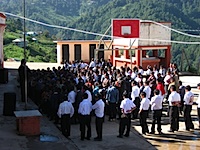 We’ve been saying all along that we need to work some in the schools, giving lectures to kids. Kids are the future of any society, and if we get to them early enough, we have a better chance of helping them to actually believe the health messages we are promoting- thing like “sickness is caused by germs, not cold drafts” or “washing your hands between using the toilet and eating dinner is a good idea”. So, after several discussions with the director and several cancelled appearances, today we finally gave our first lecture in the local school. “You better put on clean pants,” Emily joked, since mine bore some of the usual sprinkles of mud you get if you live on the side of a mountain in the Guatemalan countryside. I decided it was pointless, and just put on a clean shirt instead. Standards slide…
We’ve been saying all along that we need to work some in the schools, giving lectures to kids. Kids are the future of any society, and if we get to them early enough, we have a better chance of helping them to actually believe the health messages we are promoting- thing like “sickness is caused by germs, not cold drafts” or “washing your hands between using the toilet and eating dinner is a good idea”. So, after several discussions with the director and several cancelled appearances, today we finally gave our first lecture in the local school. “You better put on clean pants,” Emily joked, since mine bore some of the usual sprinkles of mud you get if you live on the side of a mountain in the Guatemalan countryside. I decided it was pointless, and just put on a clean shirt instead. Standards slide…
We arrived a few minutes early, while recess was still on. It was total chaos: kids running around like there was a massacre happening, screaming and shouting. Of course, within minutes, we had a THRONG of kids encircling us, gawking and giggling and pointing. There were no teachers in sight. After a few minutes of making small talk with kids (what’s YOUR name?) the assistant director came up to talk with us. A split second before he arrived, I felt something hot and wet on my hand. I looked down to see that I’d been squirted all up my pants leg with some thick orangish liquid.
I was completely caught off guard. What the hell? I looked around, not sure if I should be pissed off or if it was some sort of weird mistake. All I got back was a wall of innocent looking faces. A second later (literally) the assistant director was shaking my sticky hand, and commenting on the fact that I was wearing hot sauce. He didn’t seem concerned, as though these things just happen at school. We were whisked away to a classroom, and the issue forgotten. I was glad I’d chosen not to put on clean pants.
We were greeted by 49 students, the two highest grades (5th and 6th) brought together to receive the wisdom we’d come to disperse. That’s the teaching methodology here, you see: neat chairs lined up facing the stage we were standing on, heads figuritively flipped open on hinged lids so we could pour knowledge inside, just like the teachers do. We were introduced, then 49 notebooks simultaneously opened and pens came to the ready.
Our teaching method is participatory, so the first thing we did was to get them out of their chairs and into a circle. Then we played some games that got them moving while simultaneously asking them about various health issues. After that, we returned to the desks and picked some student volunteers to help us with an interactive play about how a healthy family comes out ahead in the long run. They were all very hesitant (normal for kids) but seemed interested, and we even got a few smiles.
Then came the worst part: review questions. As Emily has complained before, it’s like pulling teeth to get the village women to respond to a question on their own. Getting one to voice her opinion in a group setting is impossible. We thought that with the kids it might be different; we were wrong. By the time they’re young teenagers, they’re already indoctrinated. No one speaks out here, no one asks questions here, no one LEARNS here. We tried every method either of us knows to eke a response out of them, and it was the longest half hour I can remember in quite a while. When we left, Emily was shaking.
I know, you’re probably thinking, “boo-hoo”. Dude, I’ve worked with kids before. I was a camp counsellor for three summers. Other PCVs had warned us about Guatemalan classrooms, but I still wasn’t prepared for what we saw. I keep thinking of Ryan, of Katie, of Mrs. VanAken- elementary teachers I know personally, people whose life work is to teach children how to learn, how to think, how to question…not just “pour knowledge into open heads”. Like so many times before, I keep coming back to how lucky we are as Americans. Our education system is far from perfect, but it’s light years ahead of so many others, if only for its philosophical approach.